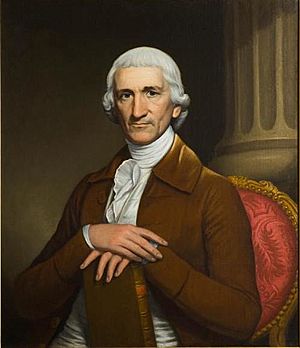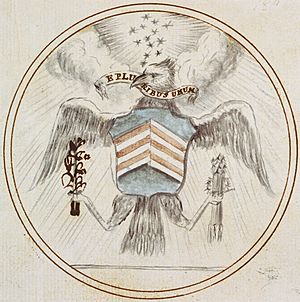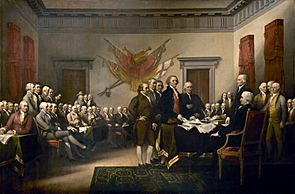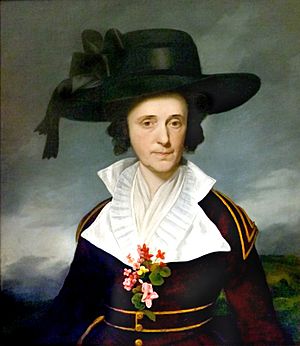Charles Thomson facts for kids
Quick facts for kids
Charles Thomson
|
|
|---|---|

Charles Thomson by Joseph Wright
|
|
| Secretary of the Continental Congress | |
| In office September 5, 1774 – July 25, 1789 |
|
| Preceded by | Position established |
| Succeeded by | Position abolished |
| Personal details | |
| Born | November 29, 1729 Maghera, County Londonderry, Ireland |
| Died | August 16, 1824 (aged 94) Lower Merion Township, Pennsylvania, U.S. |
| Resting place | Laurel Hill Cemetery |
| Spouses | 1. Ruth Mather (m. 1758, d. 1769) 2. Hannah Harrison (m. 1774, d. 1807) |
| Children | twin daughters (died in infancy) |
| Signature | |
Charles Thomson (born November 29, 1729 – died August 16, 1824) was an important leader in Philadelphia during the American Revolution. He was the secretary for the Continental Congress from 1774 to 1789, serving for its entire existence.
As secretary, Thomson kept detailed records of their meetings, known as the Journals of the Continental Congress. His name, along with John Hancock's, was on the first printed version of the United States Declaration of Independence. Thomson also helped design the Great Seal of the United States, adding its famous Latin phrases, Annuit cœptis and Novus ordo seclorum.
Contents
Early Life and Education
Charles Thomson was born in Maghera, County Londonderry, Ireland. His family were Scots-Irish migrants. In 1739, after his mother died, his father, John Thomson, decided to move to the American colonies with Charles and his brothers.
Sadly, John Thomson died during the sea journey. His belongings were stolen, and the boys arrived in New Castle, Delaware, with no money. Charles was separated from his brothers. A blacksmith in New Castle took care of him at first. He later received an education in New London, Pennsylvania. By 1750, he became a Latin tutor at the Academy and College of Philadelphia, which is now the University of Pennsylvania.
Charles Thomson's Political Career

During the French and Indian War, Thomson disagreed with the policies of the Pennsylvania leaders regarding American Indians. He worked as a secretary at the 1758 Treaty of Easton. He also wrote a book in 1759 that blamed the war on these leaders.
Thomson was an ally of Benjamin Franklin, another important figure. However, their political views changed during the crisis over the Stamp Act 1765. Thomson then became a key leader of Philadelphia's Sons of Liberty, a group that fought for American rights. He also joined the American Philosophical Society around 1750.
Secretary of the Continental Congress
Thomson was a major leader in the American Revolution in the early 1770s. John Adams even called him the "Samuel Adams of Philadelphia." Thomson served as the secretary of the Continental Congress for its entire 15-year history. Many delegates came and went during this time, but Thomson's dedication to recording debates and decisions kept things consistent.
In July 1776, Thomson's name (as secretary) appeared on the first printed version of the United States Declaration of Independence. This was alongside John Hancock, who was the president of the Congress.
Thomson's job was more than just writing things down. He was also involved in foreign affairs. Some historians even suggest he acted like a "Prime Minister of the United States."
Designing the Great Seal
Thomson is also famous for helping to design the Great Seal of the United States with William Barton. This seal was very important on January 14, 1784, when the Treaty of Paris was officially approved. This treaty ended the American Revolutionary War.
When creating the final version of the Great Seal, Thomson, who used to be a Latin teacher, kept the pyramid and eye for the back side. He changed the Latin phrases, using Annuit Cœptis and Novus ordo seclorum. He explained that the eye over the pyramid and the phrase Annuit Cœptis meant that God had helped the American cause many times.
Challenges and Retirement
Thomson's service was not always easy. He sometimes had strong disagreements with delegates over his records. These arguments were common in Congress.
Because of political disagreements, Thomson did not get a position in the new government formed by the U.S. Constitution. He resigned as secretary of Congress in July 1789. This marked the end of the Continental Congress.
Notifying George Washington
In April 1789, the Senate sent Thomson to George Washington's home. His mission was to tell Washington that he had been elected the first president of the United States. Thomson then traveled with Washington to New York for his inauguration.
Charles Thomson's Writings

As the secretary of Congress, Thomson decided what information to include in the official journals of the Continental Congress. He also wrote a very long work, over 1,000 pages, about the political history of the American Revolution.
After leaving his job, he chose to destroy this work. He wanted to protect the idea that the leaders of the War of Independence were heroes. He believed that if he revealed everything, it would "contradict all the histories" and that it was better for future generations to admire these leaders.
Thomson also contributed a 25-page appendix to the original English version of Thomas Jefferson's Notes on the State of Virginia.
Personal Life and Later Years
Charles Thomson married Ruth Mather in 1758. Sadly, she and their twin infant daughters all died in 1769. On September 1, 1774, he married Hannah Harrison (1728-1807). Hannah was the daughter of Richard Harrison, who owned Harriton Plantation in what is now Bryn Mawr, Pennsylvania.
Thomson spent his last years at Harriton House. There, he worked on translating the Septuagint version of the Bible. His translation was the first English version of the Septuagint ever published. He also published a summary of the Four Evangelists in 1815. In his retirement, he enjoyed studying agricultural science and beekeeping. In 1813, Thomson became a member of the American Antiquarian Society.
According to Thomas Jefferson, Thomson became very old and sometimes couldn't recognize his own family members. Charles Thomson passed away on August 16, 1824. He was first buried next to his wife at the Harrison Family Cemetery. Later, in 1838, they were both reburied at Laurel Hill Cemetery in Philadelphia.
Portrayals
Charles Thomson has been shown in popular culture:
- He was played by Ralston Hill in the 1969 Broadway musical 1776 and its 1972 film version.
- He was featured on a 1975 seven-cent postal card.
See also


